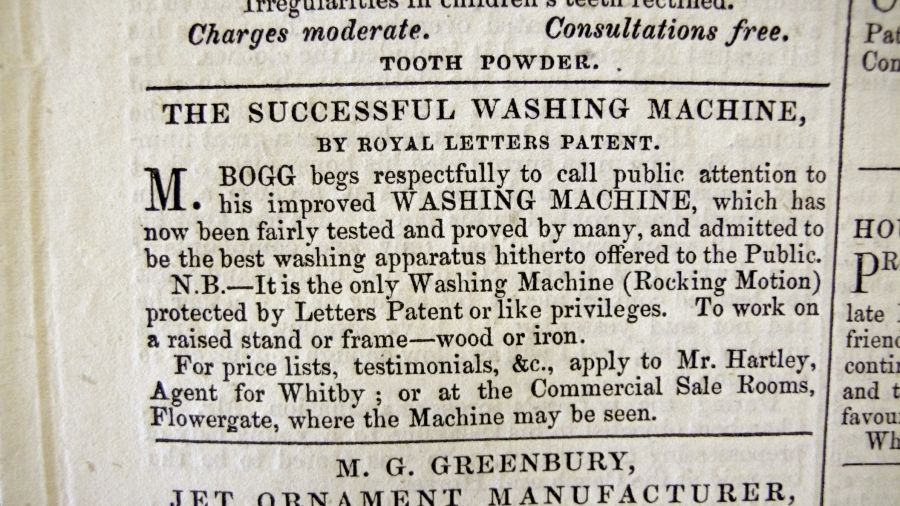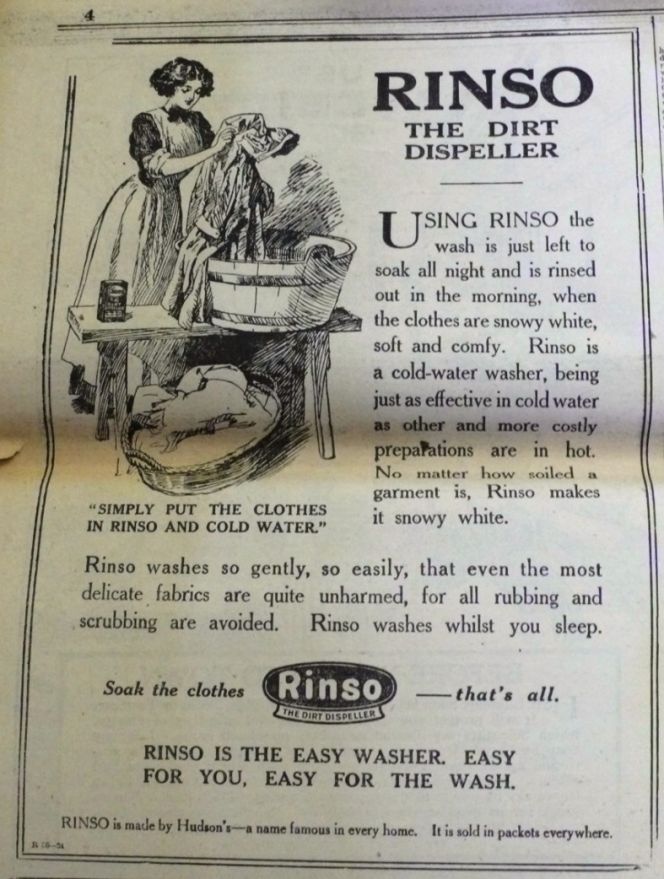ikfoundation.org
Promoting Natural & Cultural History
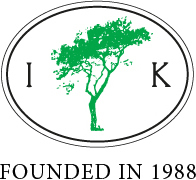


ESSAYS |
LAUNDRY & DYEING
– 1850s to 1914
Washing, starching, ironing, repairing, altering and dyeing were important processes not only for keeping clothes clean but also to ensure that they continued to be wearable and remained fresh as long as possible. Fabric, the sewing of clothes, and ready-made garments were relatively expensive investments, that needed either to be used till they were worn out, or dyed to look less unsightly or faded, or altered to conform to a more up-to-date fashion or be adapted as clothes for children. Here, we shall look at a selection of related announcements and advertisements in the local paper Whitby Gazette between 1858 and 1914.
Dry-cleaning was developed in the middle of the 19th century for textiles that could not be washed in water without shrinking or losing shape. It was an unhealthy process usually involving a petroleum-based solvent, which was also a considerable fire risk. Nonetheless dry-cleaning became extremely popular since the fine fabrics favoured by Victorian fashion: silk, velvet, fine-quality wool and every kind of lace were often combined in the same garment, making washing in water virtually impossible. Dyeing was also largely based on chemicals after the introduction in 1856 of aniline dyes, which made it possible to use new and often very strong colours – lilac, rose, turquoise – and black (1863) which were difficult and expensive or impossible to develop with natural methods. Advertisements were placed in the Whitby Gazette by no more than about ten separate firms involved in this activity between 1858 and 1910, some of them only through local agents, with the clothes being sent for dyeing or cleaning to a larger town.
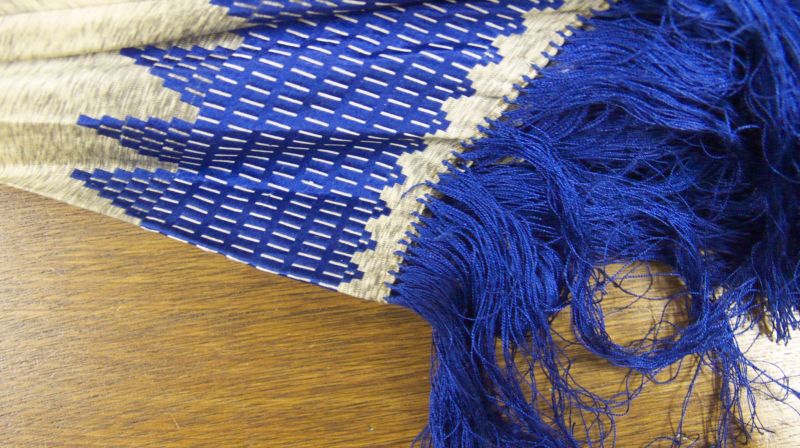 Close-up picture of 1860s parasol – from the collection in the Whitby museum – with a strong azure blue colour on silk fabric and fringe, a shade that was not possible to achieve earlier using natural dyes, but with the help of synthetic dyes became widely popular. (Collection: Whitby Museum, Costume Collection). Photo: Viveka Hansen.
Close-up picture of 1860s parasol – from the collection in the Whitby museum – with a strong azure blue colour on silk fabric and fringe, a shade that was not possible to achieve earlier using natural dyes, but with the help of synthetic dyes became widely popular. (Collection: Whitby Museum, Costume Collection). Photo: Viveka Hansen.On the other hand, a smaller advertisement in 1885 promoted the services of a washerwoman: ‘Washing wanted in the Country. Good Drying on the Moor edge – For address, apply Gazette office.’ It may be assumed that this woman soaked the washing in a tub, scrubbed it clean on a washboard and rinsed it in a watercourse if any were available before laying it out to dry in the open air, the most usual procedure throughout the 19th century and even later. After being washed collars and laces etc. needed to be stiffened to keep their form better, something to which particular attention was drawn between 1865 and 1875. This advertisement from spring 1865 refers to the then well-known ‘Glenfield Patent Starch’ manufactured by ‘Wotherspoon & Co., Glasgow & London’. It does not say where this product could be bought, but it would have been available from any well-stocked general dealer.
The new century brought repeated advertisements between 1900 and 1914 from the new Whitby Steam Laundry of Thornton & Co. in Flowergate. In April 1909 they drew attention to a new idea: ‘Carpet Cleaning by the vacuum process. This is the hygienic way of treating carpets. It removes all dust, moths and microbes without injuring the fabric. Try it.’ A year later they were still drawing attention to the excellence of their vacuum cleaner: ‘The most wonderful machine ever invented… Our Shampoo Process is a great success for reviving colours and makes Carpets look new again’. In other words, they had discovered a gentler way of cleaning carpets than the chemical methods of the second half of the 19th century. The same firm announced in 1913-1914 that they welcomed large quantities of household linen including sheets and towels, etc. with ‘Special Terms for Boarding Houses and Hotels’.
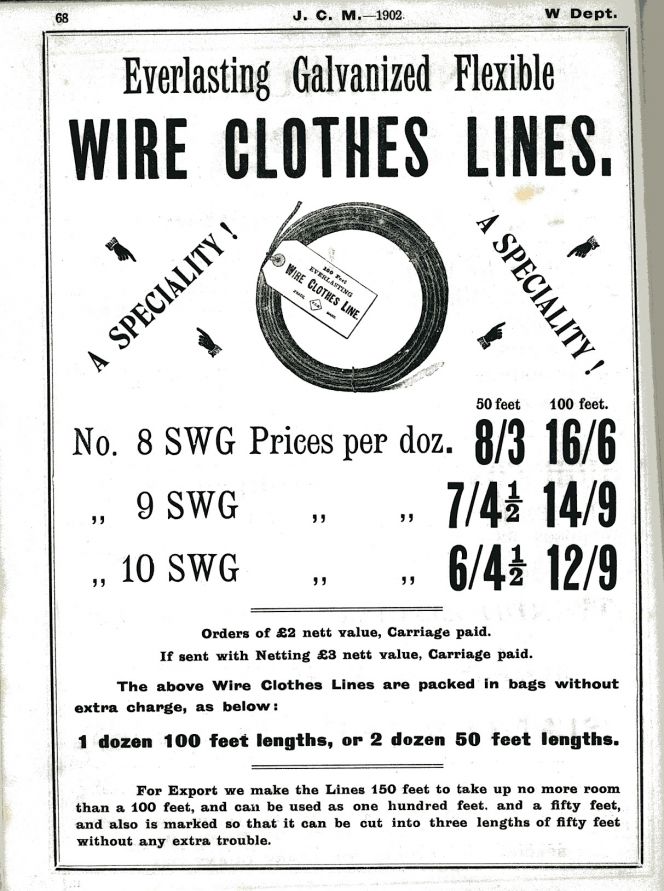 How utensils, clothes lines etc, looked like circa 1900 and what these items cost, something which is shown in the Richd. Johnson, Clapham & Morris catalog dated 1902. Among other things, ‘Everlasting Galvanised Flexible Wire Clothes Lines,’ sold in differing lengths, ‘Hemp clothes line,’ ‘Wooden Clothes peg’ and a smaller drying rack for indoors…
How utensils, clothes lines etc, looked like circa 1900 and what these items cost, something which is shown in the Richd. Johnson, Clapham & Morris catalog dated 1902. Among other things, ‘Everlasting Galvanised Flexible Wire Clothes Lines,’ sold in differing lengths, ‘Hemp clothes line,’ ‘Wooden Clothes peg’ and a smaller drying rack for indoors…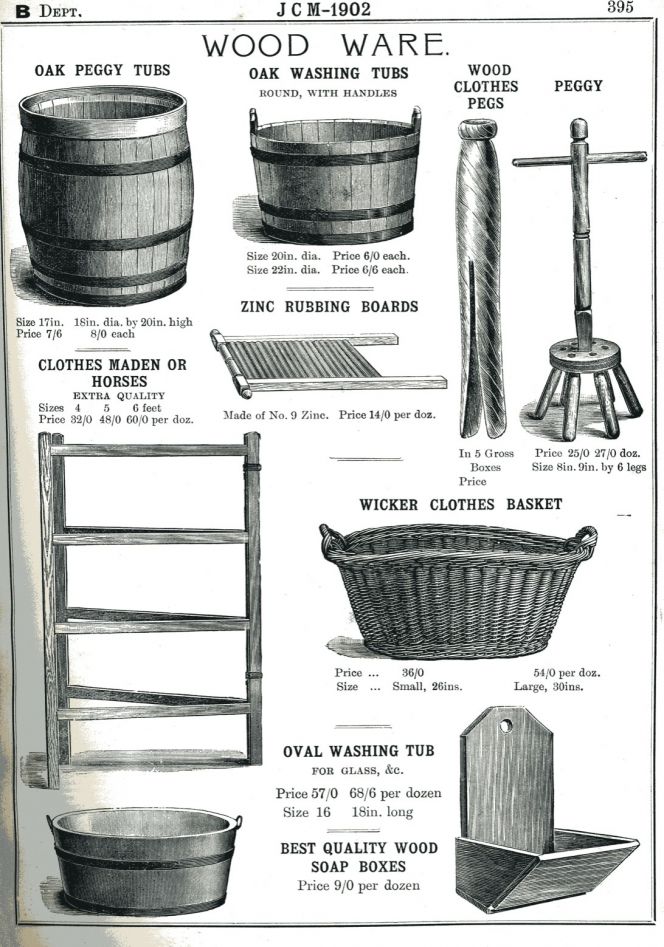 … The drying of washing occurred indoors but for the most part only during winters and periods of bad weather. Which presumably worked using either small drying racks placed on the floor or drying rods which were hung from the ceiling or through a winched up drying rack if you had the space. (General Catalogue…1902. Private owner).
… The drying of washing occurred indoors but for the most part only during winters and periods of bad weather. Which presumably worked using either small drying racks placed on the floor or drying rods which were hung from the ceiling or through a winched up drying rack if you had the space. (General Catalogue…1902. Private owner).Washing clothes assisted by electric power was a revolutionary new idea around the turn of the century, and one of the first tentative attempts at this was featured in an advertisement of 26 April 1901. ‘The Electric Laundry, Saltburn-by-the-Sea, the first Public Laundry in the Kingdom where the Machinery is driven by Electric Power. Agent for Whitby T.E. Rennie, Draper, 13, Skinner Street.’ On the other hand, a laundry with steam power was opened by G. Remmer ‘in connection with the Shirt Factory’ according to an announcement in February 1907. This firm dealt with every kind of laundry with the help of its experienced supervisor and washerwomen, and promised high-class, indeed perfect results, adding: ‘All articles dried in the open air when possible. Parcels called for and promptly returned’. A few years later – in August 1910 – an advertisement appeared for a simple type of washing-machine by R.D. Spaven & Co. promising less exhausting washing days: ‘Long, hard washing days made short and easy. The “Vollmar” will wash clothes clean without tearing any.’ Aware that the washing of clothes and home furnishing textiles was easily the heaviest and most demanding aspect of housework, it is not surprising that new products sought to find a foothold in the market. Even if the consequent improvements and simplifications in this repetitive weekly aspect of housekeeping were only small, they could still have significant importance for laundering housewives, servants and professional washerwomen, saving them time and strength.
Sources:
- Hansen, Viveka, The Textile History of Whitby 1700-1914 – A lively coast town between the North Sea and North York Moors, London & Whitby, 2015 (research material, pre-publishing).
- Richd. Johnson, Clapham & Morris Limited, General Catalogue, Manufacturers, Merchants, Hardware factors and Complete house Furnishers, Manchester 1902.
- Whitby Gazette 1855-1914 (Whitby Museum Library & Archive).
Essays
The iTEXTILIS is a division of The IK Workshop Society - a global and unique forum for all those interested in Natural & Cultural History from a Textile Perspective.
Open Access essays - under a Creative Commons license and free for everyone to read - by Textile historian Viveka Hansen aiming to combine her current research and printed monographs with previous projects dating back to the late 1980s. Some essays also include unique archive material originally published in other languages, made available for the first time in English, opening up historical studies previously little known outside the north European countries. Together with other branches of her work; considering textile trade, material culture, cloth manufacturing, fashion, natural dyeing and the fascinating world of early travelling naturalists – like the "Linnaean network" – from a Global history perspective.
For regular updates, and to make full use of iTEXTILIS' possibilities, we recommend fellowship by subscribing to our monthly newsletter iMESSENGER.
been copied to your clipboard




– a truly European organisation since 1988
Legal issues | Forget me | and much more...



